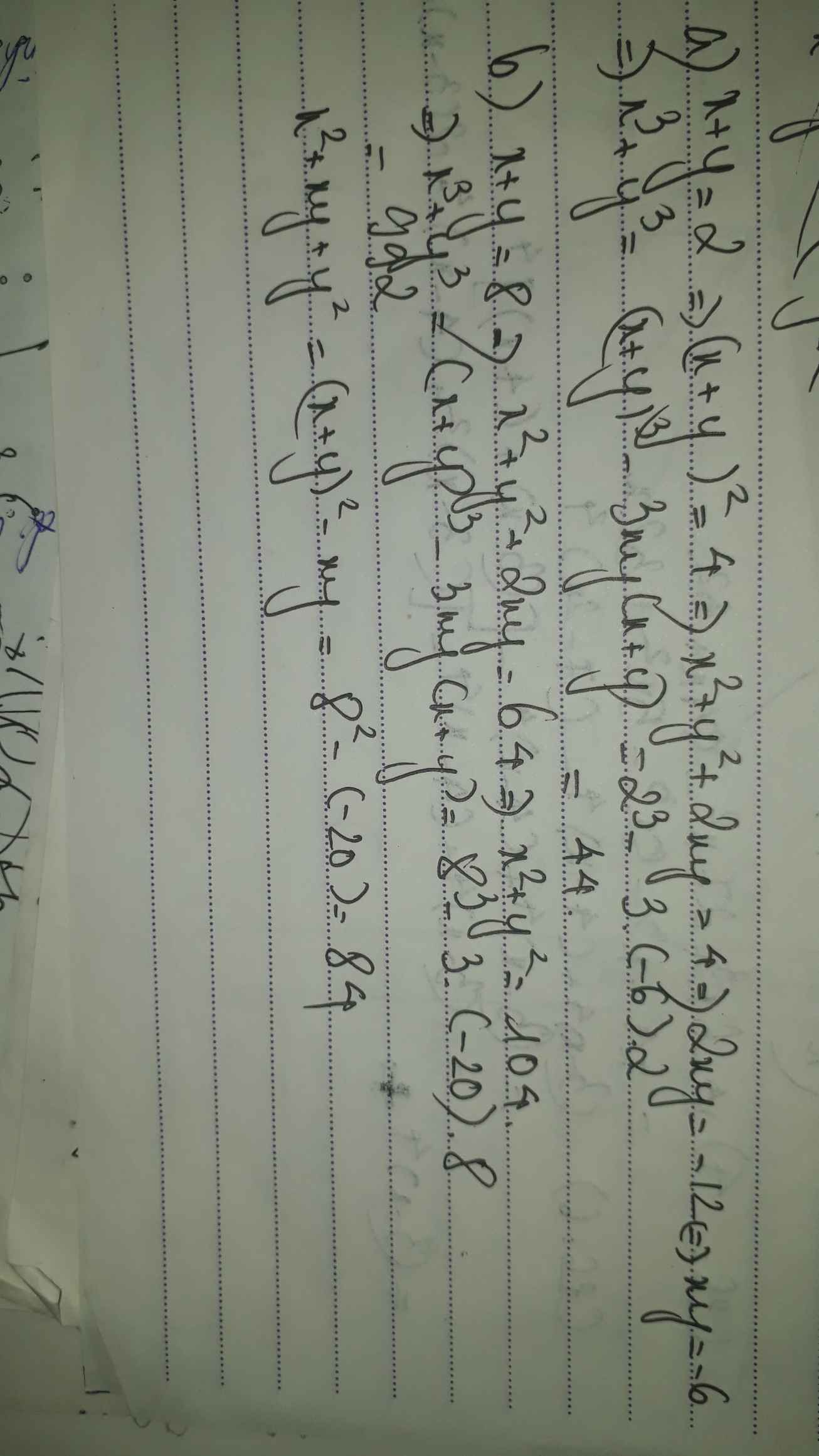Hãy nhập câu hỏi của bạn vào đây, nếu là tài khoản VIP, bạn sẽ được ưu tiên trả lời.

1)
Ta có: x+y=2
nên \(\left(x+y\right)^2=4\)
\(\Leftrightarrow x^2+y^2+2xy=4\)
\(\Leftrightarrow2xy=2\)
hay xy=1
Ta có: \(x^3+y^3\)
\(=\left(x+y\right)^3-3xy\left(x+y\right)\)
\(=2^3-3\cdot1\cdot2\)
=2
2)\(x^2+y^2=\left(x+y\right)^2-2xy=8^2-2\cdot\left(-20\right)=104\)
\(x^3+y^3=\left(x+y\right)^3-3xy\left(x+y\right)=8^3-3\cdot\left(-20\right)\cdot8=512+480=992\)
\(x^2+y^2+xy=\left(x+y\right)^2-xy=8^2-\left(-20\right)=64+20=84\)

6: \(-x^2y\left(xy^2-\dfrac{1}{2}xy+\dfrac{3}{4}x^2y^2\right)\)
\(=-x^3y^3+\dfrac{1}{2}x^3y^2-\dfrac{3}{4}x^4y^3\)
7: \(\dfrac{2}{3}x^2y\cdot\left(3xy-x^2+y\right)\)
\(=2x^3y^2-\dfrac{2}{3}x^4y+\dfrac{2}{3}x^2y^2\)
8: \(-\dfrac{1}{2}xy\left(4x^3-5xy+2x\right)\)
\(=-2x^4y+\dfrac{5}{2}x^2y^2-x^2y\)
9: \(2x^2\left(x^2+3x+\dfrac{1}{2}\right)=2x^4+6x^3+x^2\)
10: \(-\dfrac{3}{2}x^4y^2\left(6x^4-\dfrac{10}{9}x^2y^3-y^5\right)\)
\(=-9x^8y^2+\dfrac{5}{3}x^6y^5+\dfrac{3}{2}x^4y^7\)
11: \(\dfrac{2}{3}x^3\left(x+x^2-\dfrac{3}{4}x^5\right)=\dfrac{2}{3}x^3+\dfrac{2}{3}x^5-\dfrac{1}{2}x^8\)
12: \(2xy^2\left(xy+3x^2y-\dfrac{2}{3}xy^3\right)=2x^2y^3+6x^3y^3-\dfrac{4}{3}x^2y^5\)
13: \(3x\left(2x^3-\dfrac{1}{3}x^2-4x\right)=6x^4-x^3-12x^2\)

\(pt< =>\left(x-y\right)^2+xy=\left(x-y\right)\left(xy+2\right)+9\)
\(< =>\left(y-x\right)\left(xy+2+y-x\right)+xy+2+y-x-\left(y-x\right)=11\)
\(< =>\left(y-x+1\right)\left(xy+2+y-x\right)-\left(y-x+1\right)=10\)
\(< =>\left(x-y+1\right)\left(x-y-1-xy\right)=10\)
đến đây giải hơi bị khổ =))

a: Ta có: \(\left(x+y\right)^2\)
\(=x^2+2xy+y^2\)
\(\Leftrightarrow x^2+y^2=\dfrac{\left(x+y\right)^2}{2xy}\ge\dfrac{\left(x+y\right)^2}{2}\forall x,y>0\)

\(1,\\ a,=6x^4-15x^3-12x^2\\ b,=x^2+2x+1+x^2+x-3-4x=2x^2-x-2\\ c,=2x^2-3xy+4y^2\\ 2,\\ a,=7x\left(x+2y\right)\\ b,=3\left(x+4\right)-x\left(x+4\right)=\left(3-x\right)\left(x+4\right)\\ c,=\left(x-y\right)^2-z^2=\left(x-y-z\right)\left(x-y+z\right)\\ d,=x^2-5x+3x-15=\left(x-5\right)\left(x+3\right)\\ 3,\\ a,\Leftrightarrow3x\left(x+2\right)=0\Leftrightarrow\left[{}\begin{matrix}x=0\\x=-2\end{matrix}\right.\\ b,\Leftrightarrow\left(x-1\right)\left(x+2\right)=0\Leftrightarrow\left[{}\begin{matrix}x=1\\x=-2\end{matrix}\right.\)
Câu 1
a)\(3x^2\left(2x^2-5x-4\right)=6x^4-15x^3-12x^2\)
b)\(\left(x+1\right)^2+\left(x-2\right)\left(x+3\right)-4x=x^2+2x+1+x^2+3x-2x-6-4x=2x^2-x-5\)

\(x^5+y^5=\left(x^2+y^2\right)\left(x^3+y^3\right)-x^2y^3-x^3y^2\)
\(=\left(x^2+y^2\right)\left(x^3+y^3\right)-\left(xy\right)^2\left(x+y\right)\)
\(=10.26-\left(-3\right)^2.2=...\)
(x+y)5=32
⇔ x5+5x4y+10x3y2+10x2y3+5xy4+y5 = 32
⇔ x5+y5 = 32-5xy(x3+y3)-10x2y2(x+y)
= 32-5.(-3).26-10.(-3)2.2
= 242

b)
\(\left(x+2\right)^4=y^3+x^4\)
\(\Leftrightarrow y^3=\left(x+2\right)^4-x^4=x^4+8x^3+24x^2+32x+16-x^4\)
\(\Leftrightarrow y^3=8x^3+24x^2+32x+16\)
+ Vì \(24x^2+32x+16=4\left(6x^2+8x+4\right)=4\left[2x^2+4\left(x+1\right)^2\right]>0\forall x\)
\(\Rightarrow y^3>8x^3=\left(2x\right)^3\) (1)
+ Xét \(M=\left(2x+3\right)^3-y^3=8x^3+36x^2+54x+27-8x^3-24x^2-32x-16\)
\(\Rightarrow M=12x^2+22x+11=x^2+11\left(x+1\right)^2>0\forall x\) (2)
Từ (1) và (2) \(\Rightarrow\left(2x\right)^3< y^3< \left(2x+3\right)^3\)
\(\Rightarrow\orbr{\begin{cases}y=2x+1\\y=2x+2\end{cases}}\)
* Với \(y=2x+1\), thay vào biểu thức ta có :
\(\left(2x+1\right)^3=8x^3+24x^2+32x+16\)
\(\Leftrightarrow8x^3+12x^2+6x+1=8x^3+24x^2+32x+16\)
\(\Leftrightarrow12x^2+26x+15=0\)
\(\Leftrightarrow2x\left(6x+13\right)=-15\)
Vì x nguyên nên \(2x\left(6x+13\right)⋮2\), mà -15 ko chia hết cho 2 nên PT vô nghiệm
* Với \(y=2x+2\), ta có :
\(\left(2x+2\right)^3=8x^3+24x^2+32x+16\)
\(\Leftrightarrow8x^3+24x^2+24x+8=8x^3+24x^2+32x+16\)
\(\Leftrightarrow8x+8=0\)
\(\Leftrightarrow x=-1\)
Suy ra : \(y=2.\left(-1\right)+2=0\)
Vây PT có nghiệm \(\hept{\begin{cases}x=-1\\y=0\end{cases}}\)
a)
\(x^2+xy+y^2=x^2y^2\)
\(\Leftrightarrow x^2+2xy+y^2=x^2y^2+xy\)
\(\Leftrightarrow\left(x+y\right)^2=xy\left(xy+1\right)\)
Suy ra : \(\orbr{\begin{cases}xy=0\\xy+1=0\end{cases}}\)
+ Với \(xy=0\)
\(\Leftrightarrow\orbr{\begin{cases}x=0\\y=0\end{cases}}\)
Thay vào biểu thức ta đc \(x=y=0\)
+ Với \(xy+1=0\Leftrightarrow xy=-1\)
Vì x, y nguyên nên \(\left(x;y\right)\in\left\{\left(1;-1\right);\left(-1;1\right)\right\}\)
Thay vao biểu thức ta thấy thỏa mãn !
Vậy \(\left(x;y\right)\in\left\{\left(0;0\right);\left(1;-1\right);\left(-1;1\right)\right\}\)